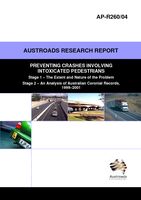Road Safety

Preventing Crashes Involving Intoxicated Pedestrians Stage 1 Report:The extent and Nature of the Problem Stage 2: An Analysis of Australian Coronial Records, 1999-2001
- Publication no: AP-R260-04
- ISBN: 0 85588 723 0
- Published: 1 December 2004
- PDF (free) Download
A literature review carried out as an earlier stage of this project concluded that there is a dearth of information regarding the basic circumstances of alcohol-affected pedestrian crashes. The present study reports a detailed analysis of crashes involving intoxicated pedestrians in the ATSB Coronial Database intended to remedy this lack of basic knowledge and formulate recommendations for addressing this problem. All records for the years 1999, 2001 and 2002 which involved the death of a pedestrian aged 16 or over who had a blood alcohol concentration of 0.05 g/100ml or greater were selected for inclusion in the study. In the time available, the research team was able to process 240 of the 304 available records. A researcher read over each report, then attempted to use the Coronial record to answer a standard set of questions about each case, relating to where, for how long and with whom the person had been drinking, who was with them when they left the drinking venue, and aspects of the setting and behaviour at the time of the crash. The general pattern of findings relating to intoxicated pedestrian crashes was replicated, the crashes being associated with male deceased, high BACs, night and weekend occurrence, and over-representation of indigenous persons. There were also new findings relating to behavioural patterns associated with this type of crash. The most frequent drinking venues were hotels and other people s homes. Deceased persons tended to have been drinking for long periods, most often six hours or more, and many were identified as drinking in company, and were almost entirely local residents. In 14% of cases, there was an argument which precipitated the deceased s leaving the drinking venue. At the time of the crash, the deceased was walking along the road in approximately 30% of cases, lying on the road in 20% of cases, sitting in the road in 2%, and standing on or near the edge of the road in a further 5%.
- AP-R260/04 AUSTROADS RESEARCH REPORT - PREVENTING CRASHES INVOLVING INTOXICATED PEDESTRIANS
- STAGE 1 REPORT - THE EXTENT AND NATURE OF THE PROBLEM
- EXECUTIVE SUMMARY
- TABLE OF CONTENTS
- 1. INTRODUCTION
- 2. SCOPE OF THE PROBLEM
- 3. PROGRAMS TARGETED AT ALCOHOL-AFFECTED PEDESTRIANS
- 4. CURRENT POLICY POSITIONS
- 5. AVAILABLE COUNTERMEASURES
- 6. CURRENT SITUATION IN AUSTRALIA
- 7. RECOMMENDATIONS FOR STAGE 2
- BIBLIOGRAPHY
- STAGE 2 REPORT - AN ANALYSIS OF AUSTRALIAN CORONIAL RECORDS, 1999-2001
- EXECUTIVE SUMMARY
- TABLES OF CONTENTS
- 1. INTRODUCTION
- 2. METHOD
- 3. RESULTS
- 4. DISCUSSION
- 5. RECOMMENDATIONS
- BIBLIOGRAPHY
- APPENDIX - ADJUSTING FOR THE OVER-REPRESENTATION OF INDIGENOUS PERSONS
Related publications
Latest Road Safety News
